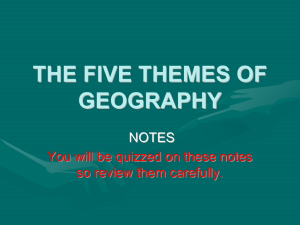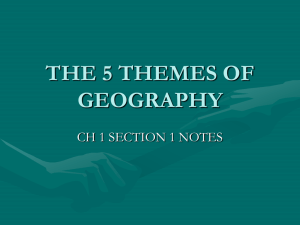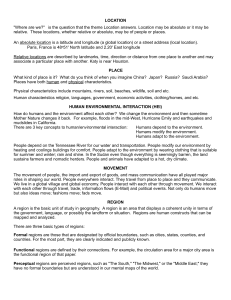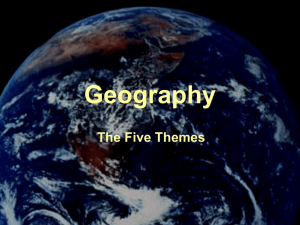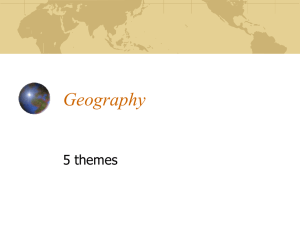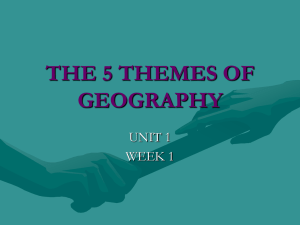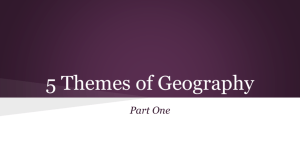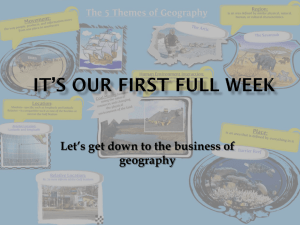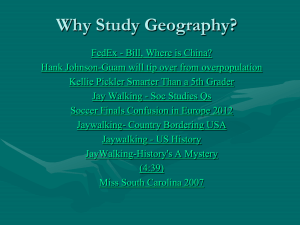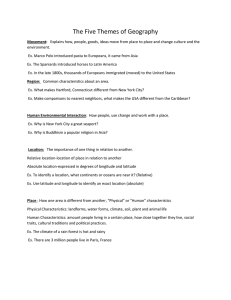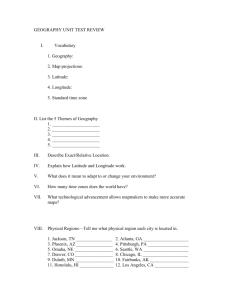5 themes notes for sharing if necessary
advertisement
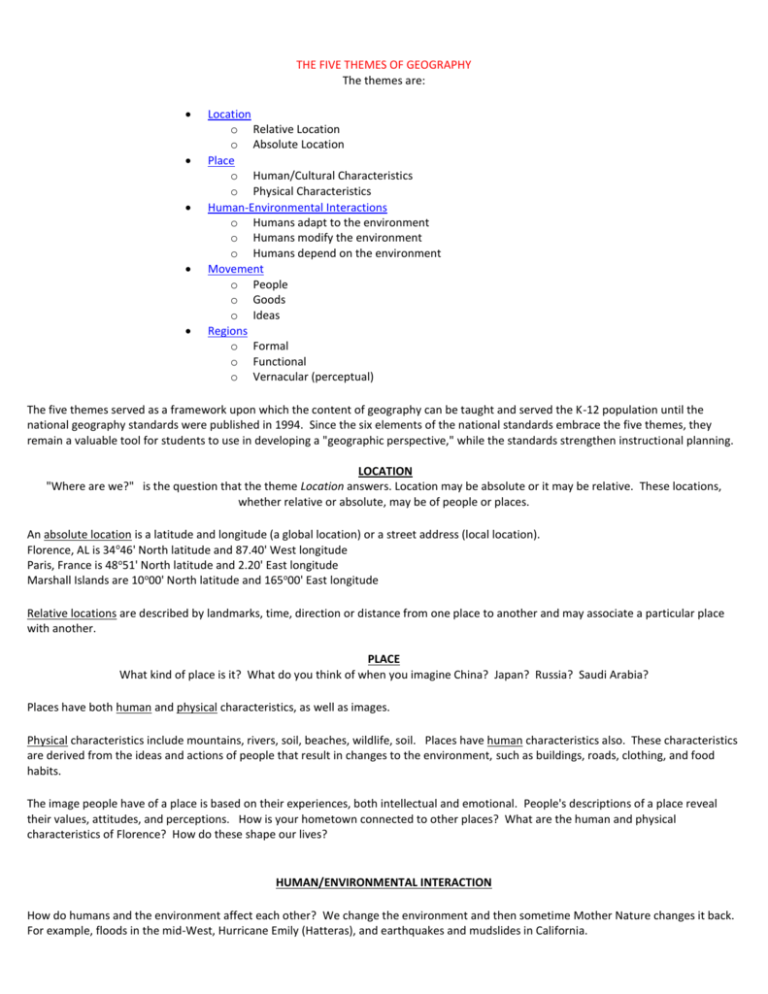
THE FIVE THEMES OF GEOGRAPHY The themes are: Location o Relative Location o Absolute Location Place o Human/Cultural Characteristics o Physical Characteristics Human-Environmental Interactions o Humans adapt to the environment o Humans modify the environment o Humans depend on the environment Movement o People o Goods o Ideas Regions o Formal o Functional o Vernacular (perceptual) The five themes served as a framework upon which the content of geography can be taught and served the K-12 population until the national geography standards were published in 1994. Since the six elements of the national standards embrace the five themes, they remain a valuable tool for students to use in developing a "geographic perspective," while the standards strengthen instructional planning. LOCATION "Where are we?" is the question that the theme Location answers. Location may be absolute or it may be relative. These locations, whether relative or absolute, may be of people or places. An absolute location is a latitude and longitude (a global location) or a street address (local location). Florence, AL is 34o46' North latitude and 87.40' West longitude Paris, France is 48o51' North latitude and 2.20' East longitude Marshall Islands are 10o00' North latitude and 165o00' East longitude Relative locations are described by landmarks, time, direction or distance from one place to another and may associate a particular place with another. PLACE What kind of place is it? What do you think of when you imagine China? Japan? Russia? Saudi Arabia? Places have both human and physical characteristics, as well as images. Physical characteristics include mountains, rivers, soil, beaches, wildlife, soil. Places have human characteristics also. These characteristics are derived from the ideas and actions of people that result in changes to the environment, such as buildings, roads, clothing, and food habits. The image people have of a place is based on their experiences, both intellectual and emotional. People's descriptions of a place reveal their values, attitudes, and perceptions. How is your hometown connected to other places? What are the human and physical characteristics of Florence? How do these shape our lives? HUMAN/ENVIRONMENTAL INTERACTION How do humans and the environment affect each other? We change the environment and then sometime Mother Nature changes it back. For example, floods in the mid-West, Hurricane Emily (Hatteras), and earthquakes and mudslides in California. There are three key concepts to human/environmental interaction: Humans adapt on the environment. Humans modify the environment. Humans depend to the environment. People depend on the local rivers for our water and transportation. People modify our environment by heating and cooling buildings for comfort. People adapt to the environment by wearing clothing that is suitable for summer or winter; rain or shine. All places on Earth have advantages and disadvantages for human settlement. One person's advantage may be another person's disadvantage. Some like the excitement of large cities whereas others prefer remoteness. Environment is not just trees, spotted owls, and rain forests. Environment is a feeling. What is the environment of a city? Boston? Dallas? Given the choice, where would you live? Why? What is the environment? How do people interact with the environment? How do the physical features affect us? How have we adapted to or changed our landscape? For example, in the Sudan even though everything is seemingly barren, the land sustains farmers and nomadic herders. People and animals have adapted to a hot, dry climate. MOVEMENT The movement of people, the import and export of goods, and mass communication have all played major roles in shaping our world. People everywhere interact. They travel from place to place and they communicate. We live in a global village and global economy. People interact with each other through movement. Humans occupy places unevenly on Earth because of the environment but also because we are social beings. We interact with each other through travel, trade, information flows (E-Mail) and political events. Not only do humans move but also ideas move; fashions move; fads move. What is an example of an idea that moves? Fashion? Fad? How do we depend on people in other places? How would our lives change if our movement options changed? What would happen if we traveled by camel or horse? How do we move from place to place? How do we actually get food? REGION A region is the basic unit of study in geography. A region is an area that displays a coherent unity in terms of the government, language, or possibly the landform or situation. Regions are human constructs that can be mapped and analyzed. There are three basic types of regions. Formal regions are those defined by governmental or administrative boundaries (i. e., United States, Birmingham, Brazil). These regional boundaries are not open to dispute, therefore physical regions fall under this category (i. e., The Rockies, the Great Lakes States). Functional regions are those defined by a function (i. e., TVA, United Airlines Service area or a newspaper service area). If the function ceases to exists, the region no longer exists. Vernacular regions are those loosely defined by people's perception (i. e., The South, The Middle East). In what region do we live? What type of region is it? What are its characteristics? South, North Alabama, the Shoals, the University community? What states do you define as the South? The Northeast? The Bible Belt? What characteristics and perceptions go along with these regions?
